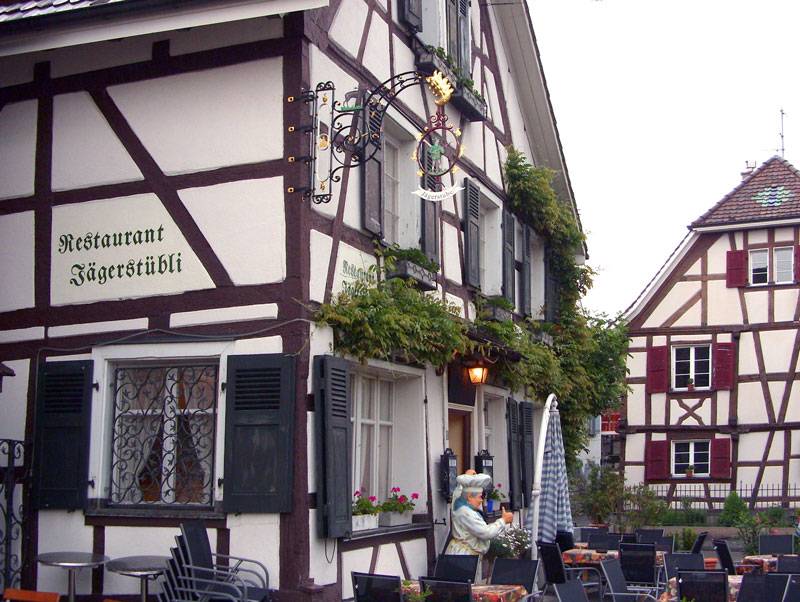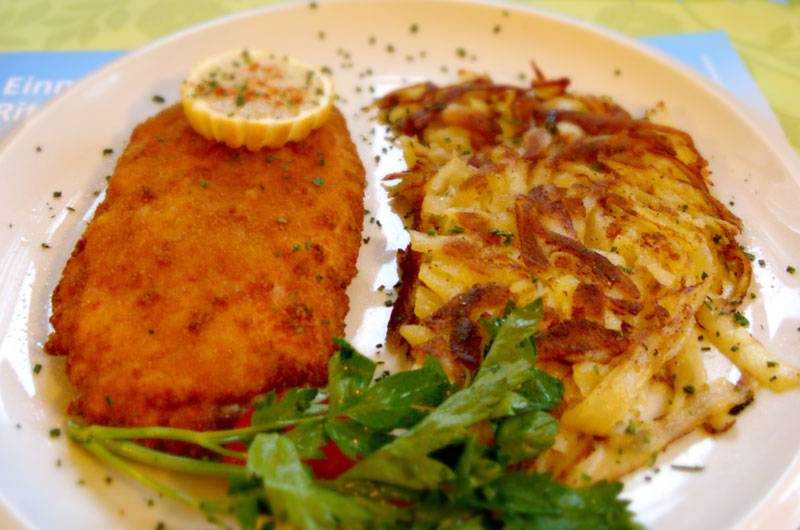 Editor’s Note: For the next month or so, our roving food writer will be reporting from Europe.
Editor’s Note: For the next month or so, our roving food writer will be reporting from Europe.
An advantage of teaching at Parkland College is the privilege of participating in international exchange programs. Last year, I was accepted and matched with an exchange partner from Switzerland. In October 2007, I hosted Immanuel Willi, an IT professional at University of Applied Sciences/Northwestern Switzerland in Basel. He stayed with us in Champaign for two weeks, and now it’s my turn to to stay with him in Basel.
Although Basel is technically in Switzerland, it is an international city at the crossroads of Germany, France and Switzerland. In fact, in Basel, one says merci more often than danke. Although German is the primary official language, just about everyone speaks some English. That is, everyone except the waitress at the first restaurant we dined at. At my request to try a traditional Swiss restaurant, Immanuel took me to the village of Allschwil, a former Swiss village that has almost been swallowed up by the city of Basel. Today, Allschwil is the last stop on Basel’s number 6 tram line — way off the tourist path. And right across the street from the tram stop stands the Jägerstăbli, a local hangout that has been there for decades.
Seeing that there are foreign visitors in her restaurant, our waitress was very excited and insisted we try the house specialties. We started with a sausage and cheese salad made with Cervelat sausage, a Swiss delicacy that may not be around much longer. Due to European Union restrictions, the sausage casings that are made from Brazilian cow intestines may no longer be imported and no suitable replacement has been found. The sausage itself was rather mild, with a subtle smoky flavor. But when mixed with a freshly grated local cheese, the combined flavors skyrocketed to an irresistible high.
 For dinner, I ordered the Cordon Bleu, another house specialty. Although usually associated with Austria, the Swiss version I had was made with pork instead of veal. Stuffed with cheese and then breaded, the cutlet is fried to a nice crispy brown. The pork was tender and the melted cheese oozed out as expected, coating the meat for that extra zest. As a side dish, I had to try the rösti, a nicely seasoned Swiss potato dish not much different than our hash browns. Dinner was washed down with a glass of Feldschlösschen, the local bee everyone loves. All-in-all, a satisfying meal, but not exactly memorable.
For dinner, I ordered the Cordon Bleu, another house specialty. Although usually associated with Austria, the Swiss version I had was made with pork instead of veal. Stuffed with cheese and then breaded, the cutlet is fried to a nice crispy brown. The pork was tender and the melted cheese oozed out as expected, coating the meat for that extra zest. As a side dish, I had to try the rösti, a nicely seasoned Swiss potato dish not much different than our hash browns. Dinner was washed down with a glass of Feldschlösschen, the local bee everyone loves. All-in-all, a satisfying meal, but not exactly memorable.
 So when I was invited to lunch the next day by the director of the university, I decided to order something more exotic. We ate at another traditional Swiss restaurant called Kreuz Olten in the old medieval part of Olten, a village about 30 minutes south of Basel by train. As is my habit, I scanned the menu for something I’ve never tried before, and when I saw “calf’s head” on the menu, I was ecstatic. Despite the raised eyebrows of our waiter, I insisted that this is indeed what I desired for lunch. My over-active imagination had the calf’s head arrive on a plate complete with eyeballs intact. Instead, it was elegantly presented, chopped into bite-sized pieces surrounded by boiled potatoes. The meat itself was very tender, but it was the fatty tissue attached to the meat that really made the dish unique. Soft and melt-in-your-mouth tender, the meat was more texture than flavor. Fortunately, a strong vinegared dipping sauce infused with pickles, chives, and chopped tomatoes was served on the side — greatly enhancing the otherwise bland dish.
So when I was invited to lunch the next day by the director of the university, I decided to order something more exotic. We ate at another traditional Swiss restaurant called Kreuz Olten in the old medieval part of Olten, a village about 30 minutes south of Basel by train. As is my habit, I scanned the menu for something I’ve never tried before, and when I saw “calf’s head” on the menu, I was ecstatic. Despite the raised eyebrows of our waiter, I insisted that this is indeed what I desired for lunch. My over-active imagination had the calf’s head arrive on a plate complete with eyeballs intact. Instead, it was elegantly presented, chopped into bite-sized pieces surrounded by boiled potatoes. The meat itself was very tender, but it was the fatty tissue attached to the meat that really made the dish unique. Soft and melt-in-your-mouth tender, the meat was more texture than flavor. Fortunately, a strong vinegared dipping sauce infused with pickles, chives, and chopped tomatoes was served on the side — greatly enhancing the otherwise bland dish.
This being Europe, it was only natural to share a bottle of wine at lunch. Our hosts chose a wonderfully balanced Swiss pinot noir called Malanz Steinböeckler, explaining that the Swiss love it so much that they drink it all, so there’s nothing left to export.
Next week, we’ll be heading into the Alps, so perhaps we’ll get to taste another side of Switzerland.








